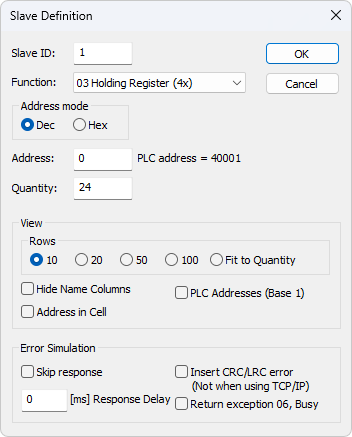

The first traffic capture is querying the coils in our slave. You have to use -r1 to read coils and with -r3 you can read holding registers. Now switch over to your Linux client with MBTGET installed. Remember these are booleans, so the value is either 0 or 1. Ideally you also alter the value of some of the coils. After downloading ModbusPal you can run it withĪdd a slave, edit the slave and add some coils. Modbus TCP traffic runs on tcp/502.įirst we have to setup ModusPal to emulate a Modbus slave. Later on you can then read the pcap files with Wireshark. Sudo "/Applications/VMware Fusion.app/Contents/Library/vmnet-sniffer" -w modbus.pcap vmnet8 The network captures are done with the use of vmnet-sniffer to get the traffic between different virtual machines running on OSX. Conpot (a Modbus -ICS- honeypot for Linux)įor my setup I used ModbusPal (Slave) on a Kali VM host and MBTGET (Master) on a Linux VM host.ModScan (a Master application on Windows).CAS Modbus Scanner (a Master application on Windows).Modbus poll (a Master application on Windows).There are a couple of alternatives that you can use to play with Modbus. MBTGET is a simple modbus/TCP client write in pure Perl. You can then query the Modbus instance with MBTGET.

It is a Java application that allows you to play with different slaves (registers and coils). You can use ModbusPal to simulate the behavior of a Modbus slave. If you setup a Modbus client remember that it can not have unit id 0! Modbus traffic Messages sent to 0 can be accepted by all slaves. The unit id of 0 can be seen as a broadcast address. In that case the unit id might have to be set to 255. In some cases however you will run into a situation where multiple devices are connected to one IP address (for example ‘bridges’). In most cases you don’t need a unit id because you already addressed the correct unit via its IP address. Unit identifiersĪ word on Modbus unit devices. a holding register is a read/write type for longer values (16 bits), starting from 40001 to 49999 īe aware that, depending on the hardware implementation, sometimes the registers start at 0 and sometimes they start at 1.an input register is a read only type for longer values (16 bits), starting from 30001 to 39999.a discrete input is a read only type for booleans, starting from 10001 to 19999.It is read/write and starts from 00001 to 09999 a coil is used for storing simple booleans (1 bit).Each of these datastore types is a reference to a memory address. Each of these datastore types has two different types of registers : a read/write and a read only. There are two types of places where information can be stored : coils and registers. Most functions allow to read or write data from/to a PLC.
#Modbus tcp addressing code
#Modbus tcp addressing serial
In the serial world, the devices have to been connected in a daisy-chain manner, not in a star topology. You can have only one Master on a “Modbus” network and maximum 247 slaves, each with a unique slave ID.


 0 kommentar(er)
0 kommentar(er)
